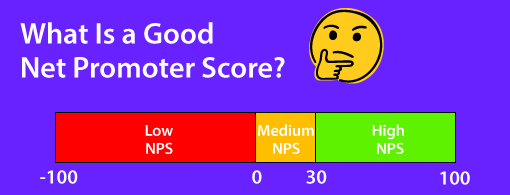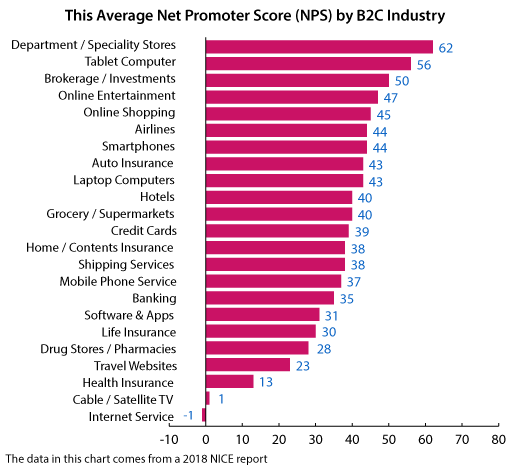We give a definition of Net Promoter Score (NPS) before discussing how the metric is best used in the contact centre.
What Is NPS and How Is It Calculated?
The Net Promoter Score (NPS) is based on a question which asks how likely a customer is to recommend an organization to a friend or family member.
Customer responses to this question are then combined into the NPS metric.
This question proved more reliable in predicting customer loyalty than several others.
In studies conducted by Fred Riechheld several years ago, this question proved more reliable in predicting customer loyalty than several others.
To calculate NPS, many brands ask customers at specific interaction points the following question to customers: “On a scale of 0-10, how likely are you to recommend our product/service to a friend or family member.”
This question can be asked as a general statement to understand how well the relationship is perceived or it can be asked at specific customer touchpoints to understand how well that specific interaction was received by the customers.
Based on their response, customers are divided up into three categories, which are:
- Promoters – Customers that respond to the NPS question with an answer of nine or ten.
- Passives – Customers that respond to the NPS question with an answer of seven and eight.
- Detractors – Customers that respond to the NPS question with an answer between zero and six.

An organization counts up its total number of promoters and deducts the detractors, before using the following formula to calculate NPS. Passives are not counted as they are deemed neutral scores.

This is the basic process for calculating NPS, but as the years have gone by, many organizations have started to adjust how they word the question.
Instead of asking the customer how likely they are to recommend their product or service, some companies ask about the likelihood of the customer recommending different aspects of their customer experience.
For example, these aspects may include:
- The likelihood of a customer recommending our customer service
- The likelihood of a customer recommending our delivery service
- The likelihood of a customer recommending our website
Yet it’s important not to dilute the question, otherwise it invalidates the purpose, and purists would suggest that any deviation from the question’s wording will invalidate the reliability of the scores against a measure of loyalty.
A Good Net Promoter Score Varies Across Industries
For many, a good Net Promoter Score will generally be above +30, as this score shows that an organization has a good deal more promoters than it does detractors.

However, this is a very general principle, as what equates to a good NPS result will vary from one industry to another.
Just take a look at the following graph, which shows the average NPS score varies across different industries:

This graph uses data from a 2018 NICE Satmetrix report.
As you can see from the variability in the chart, when debating what a good NPS is, we can only give very generic advice, as it varies so much from one industry to another.
Why? Because some sectors lend themselves more naturally to be a topic customers would authentically talk to others about (e.g. hotels versus funeral insurance), so it is inaccurate to compare scores across sectors.
A better approach to NPS is targeting incremental improvement on what you have previously been achieving. But, even before that, you must begin by establishing the metric’s purpose.
Setting the Purpose of Net Promoter Score Is Key
NPS is a perceptual question. We ask customers what they think and they tell us their inferences. But a customer who says they will recommend you probably won’t.
Connecting the NPS to a business outcomes (such as loyalty) is what’s important, and this is one reason behind why it’s important to consider the “how” and “when” of NPS. But there are others…
The “How” of NPS Is Important Because…
Let’s say that you ask the traditional NPS question to a customer, which is: “On a scale of 0-10, how likely is it that you would recommend our product/service to friends?”
From this question, you can see that NPS does not assess the contact centre in isolation but the whole business, and therefore includes actions which are outside of the contact centre’s control.
NPS does not assess the contact centre in isolation but the whole business and therefore includes actions which are outside of the contact centre’s control.
So, if your purpose for measuring NPS is to improve contact centre performance, you are going to have to carefully rethink your approach.
The standard NPS question relates to the overall customer relationship. If you choose to exchange this for a specific touchpoint, such as the contact centre experience, remember the perceptive score still relates to overall loyalty.
The When of NPS Is Important Because…
If your NPS purpose is business-wide, you also need to be wary of asking the question to customers who are in the middle of their customer journey, as their emotional response towards your company is likely to change.
Just Don’t Think of Net Promoter Score as the Be All and End All
NPS has become a default measure for many. But a one-size-fits-all solution does not exist when it comes to selecting the right metrics for your contact centre. Yet this was how NPS was marketed.
The Harvard Business Review study, from which the metric derived, even described it as: “The One Number You Need to Grow”.
But measuring customer performance is complex. Because of this, NPS has many detractors as well as promoters.

Christopher Brookes
“In the original study, 11 out of 14 tests showed that NPS was the best indicator of customer loyalty versus other tested measures,” says Christopher Brooks, Managing Director at Clientship.
“But contact centres are often not measured on recommendations and long-term loyalty. Instead, call centres measure performance based on tangible call outcomes.”
This is a key point, and there are reasons for this and why contact centres need more than just a loyalty metric…
An Example of Why Contact Centres Need More Than Just NPS
You may well find that a customer who gives you a high score really likes dealing with you, but they decide that your service just isn’t for them any more.
Why? Maybe because the customer can no longer afford your product/service, or they have moved out of the appropriate age bracket or something like that.

You may well find that a customer who gives you a high score really likes dealing with you, but they decide that your service just isn’t for them any more.
So the outcome for the contact centre is bad, because they didn’t save the sale, but NPS is still giving you a good score, because that customer would still recommend your organization.
This example can cause real confusion for the contact centre, because you are achieving your NPS target, but the customer isn’t actually doing what you want them to do. There is a clear disconnect here.
We often find that, although NPS is becoming an industry default, many still don’t fully understand the metric, just like in this example. This is just one mistake in how contact centres are using NPS.
5 More Mistakes in How Contact Centres Use NPS
Here are five more ways in which contact centres are misusing NPS, according to Christopher Brookes.
1. Confusing the Score With a Net Promoter System
With the shorthand NPS, some companies confuse a Net Promoter Score with a Net Promoter System.
One such company which made this mistake was only measuring satisfaction and effort within its system – not recommendations.
This company believed that its promoters were at the high end of satisfaction, not realizing that NPS is about correlating that with people who then go out and advocate for your brand.
If you are also still unsure of how to measure NPS, read our article: How to Calculate… Net Promoter Score
2. Failing to Consider the Outside Impact on NPS Results
NPS reflects variables that the contact centre cannot control.
Customers won’t detach the contact centre from other departments…
Customers won’t detach the contact centre from other departments, even when they are asked to focus on the call that they have just experienced.
This outside impact is a key reason why contact centres can’t benchmark NPS externally (mistake 5).
3. Failing to Relate NPS to a Business Outcome
NPS is only relevant if it relates to an outcome that the business is trying to achieve.
If you notice that when NPS goes down, repeat sales go down – for example – then you are onto something.
When NPS doesn’t relate to any key business aims, that’s when you really need to reconsider why you are using the metric.
4. Undermining Empathy
If you have dealt with a really intense call, where you have had to show a good amount of empathy, you can really undermine that by asking the customer straight after the call a question which goes along the lines of: “Will you tell your friends about me?”
So perhaps, in certain cases, that first follow-up question shouldn’t be about gaining the recommendation.
The reason why most contact centres do go for it straight away is because they think that if they have an NPS response and nothing else, at least they have the score.
But you didn’t approach the main body of the call like that – so why would you treat the follow-up in this way?
For more on the topic of using empathy to benefit the contact centre, read our article: How to Coach Empathy in the Contact Centre – With Three Training Exercises
5. Using NPS for External Benchmarking
Not every business measures NPS by asking the same question, so – like most other customer experience metrics – it should not be used as an external benchmark.
Another reason for this is that NPS reflects variables that are out of the contact centre’s control. These variables may include being slammed in the press for overpricing or for poor corporate governance, or product recalls, etc.
You cannot benchmark yourself against other contact centres, as the customer’s perceptions of the companies will be very different, which will impact your score.
So, you cannot benchmark yourself against other contact centres, as the customer’s perceptions of the companies will be very different, which will impact your score.
However, internal benchmarking of NPS over time can work well and this is where you will obtain many of your useful NPS insights.
For more on the topic of benchmarking, read our article: Contact Centre Benchmarking – How to Get More From Your Metrics
Hard Work Is Required to Make NPS a Success
While there has been a lot of cynical commentary regarding NPS so far in this article, it can work well, but you have to be prepared to do the hard graft.
To start with, you need to define your purpose, around your intended business outcomes, and then – in light of your purpose – you want to ask the right question at the right time.

People don’t do their hard work. They think that if customers are recommending them, everything must be coming together – which isn’t always the case.
Yet, according to Christopher: “People don’t do their hard work. They think that if customers are recommending them, everything must be coming together – which isn’t always the case.”
What can happen then is that organizations start chasing an NPS target, which can be a problem.
As Goodhart’s Law suggests: “When a measure becomes a target, it ceases to be a good measure.”
Organizations where your industry regulator makes NPS a mandatory measure – as the CMA (banking) and OFWAT (water) do – need to be especially careful of this.
3 Good Ways to Improve Your Net Promoter Score
Once you have ensured that you are not falling into any of the NPS traps that are highlighted above, you can apply the following strategies in order to continuously improve your results over time.
1. Learn Grom Your Promoters
If you measure NPS, make sure you do something with the results.
“We worked with a brand who went out to their promoters and asked them: ‘You said you would recommend us to someone else, can I ask you how many times that you’ve actually done that?’ Only 20% of their promoters said that they had,” says Christopher.
This represents a big missed opportunity. When you achieve high advocacy ratings, you want to think more about how you can make them work for you.
As an example, when somebody gives you a score of ten, it’s very easy to go back to them to say thank you in a positive and friendly way. You can suggest you would be happy for them to share their feedback with others, providing a link to TrustPilot to make it easier for them to do this.
The key is to use NPS as a system.
2. Go Back and Listen to High-Scoring Calls
If you are running through quality analysis (QA) in the contact centre and you see a great selection of calls after which the customer scored nine/ten, go back and listen through them. Extract and analyse them.
Build your QA programme around your key findings.
Look at the language that advisors are using to achieve that outcome and how the customer’s approach shifts from being defensive to being more supportive. You can then build your QA programme around your key findings.
Likewise, make sure that you understand from your detractors where your issues are. And when you move a customer from a low score to a high score, it’s good to take the time to look into how you were able to achieve that.
3. Get Your Call Reason Codes Right
When you have done your research into what’s causing low NPS and go to visit the team responsible, a disagreement may ensue where the team argues: “That’s not on us.”
It is very hard to get past this point when the call reason coding in the contact centre is too generic.
When the problematic calls were taken, it will never be clear where the problem lies if the call reason codes are unclear and up for debate.
This does not only create mistrust internally, it also makes it much harder for the business to see what is causing customers to become detractors.
So getting your contact centre call reason codes right is crucial. Make sure you review these regularly and that new starters understand this.
For more advice for improving your NPS results in the contact centre, read our article: 16 Ways to Improve Your Net Promoter Score
5 Key Takeaways
To finish up, let’s take a look at five key takeaways for improving the use of NPS in your contact centre, as shared with us by David Naylor, Founder of Humanotics.
These five points relate closely to some of the insights already shared and are great if you are looking for some key insights to take away from this article.
1. Make NPS a Key KPI Across the Business – NPS must be led from the executive level, in order to make it THE thing and not just another thing.
This pressure will help everybody to understand the role that they play in the NPS result and should encourage other departments to take on board key contact centre NPS insights.
2. Be Deliberate About When You Survey – Think about the results that you are getting and how those results vary across your contact centre.
See how your NPS changes from sales calls, pre-service calls and post-service calls and question that.
See how your NPS changes from sales calls, pre-service calls and post-service calls and question that. This will help you to determine if you are surveying at the right points.
3. Analyse Your Key NPS Drivers – Get skilled NPS insight experts from across different departments to undertake robust analysis so you can understand your key NPS drivers.
This is a task that many neglect or try to give to teams that are also working on other projects, but ideally you will have a day-to-day business as usual team that will focus on this.
4. Communicate Key Verbatim, Not Just Scores – By listening back to calls and listening to the transcripts that resulted in the low score, you can add much greater context to the issue.
Sharing this verbatim feedback from customers who leave a low NPS score with the department at fault will really help to bring a problem to life.

David Naylor
5. Make Things Quick – If you get a zero or a one score today, call that customer back straightaway and try to save them – so you are using NPS as system, not just a score.
There is no point in feeding these low scores into a long monthly process that will eventually get to the point where something gets fixed. That closing the loop process has got to happen quicker.
If you are looking for more insights on the topic of Net Promoter Score, these articles may also prove useful:
- How to Calculate an Employee Net Promoter Score
- NetPromoter vs Customer Effort – Which Is Best?
- 5 Strategies for Improving Your NPS Score
Author: Robyn Coppell
Published On: 11th Nov 2020 - Last modified: 18th Aug 2025
Read more about - Call Centre Management, Key Performance Indicators (KPIs), Management Strategies, Metrics, Net Promoter Score (NPS)







































